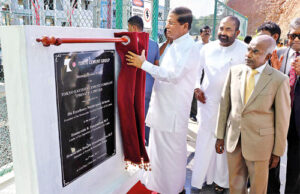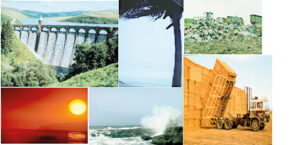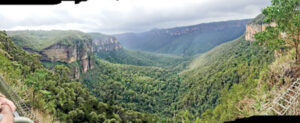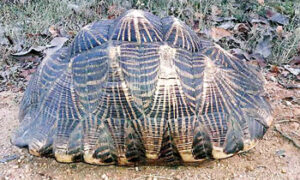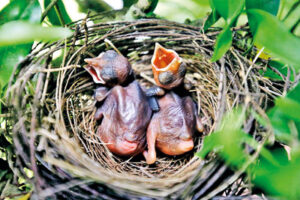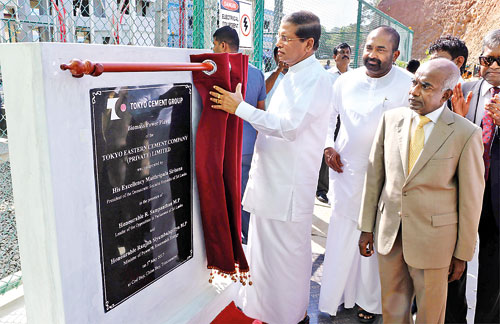
Tokyo Cement opens 2nd biomass power plant in Trinco
President Maithripala Sirisena last week ceremoniously inaugurated Tokyo Cement’s second Biomass Power Plant in Trincomalee as part of a series of events held in commemoration of the late founder Chairman A.Y.S. Gnanam.
The events included the foundation laying ceremony for a housing project for 25 families displaced during the war, distribution of deeds to residents of the Tokyo Cement Tsunami Housing Scheme in Nilaveli, foundation laying for a Technical Building and the commissioning of the Biomass Power Plant inside the Tokyo Cement Factory Premises at Cod Bay, China Bay.
“Mr. Gnanam was a pioneering entrepreneur who ventured into many of Sri Lanka’s firsts, which included the generation of Renewable Biomass Energy. President Sirisena’s visit to the Tokyo Cement Factory to inaugurate the company’s 2nd Biomass Power Plant with a capacity of 8 MW to power the company’s latest manufacturing facility, was a salute to his legacy that will continue to live on for generations to come,” the company said in a media release.
The over 2.5 billion-rupee power plant will add 70 Gwh per year to the national grid generated using industrial and agricultural waste sourced through community trade. In total, the plant will produce 160,000 MW Hours of clean renewable energy per year, equivalent to the annual electricity consumption of 100,000 Sri Lankan rural households.
S.R. Gnanam, Managing Director of Tokyo Cement said that the company has become the single largest contributor of renewable energy in the nation, generating 23 MW with the ability to supply 2.5 MW surplus capacity to the national grid.
Sourcr – http://www.sundaytimes.lk/170514/business-times/tokyo-cement-opens-2nd-biomass-power-plant-in-trinco-239700.html

KVPL Bags Top Accolade At Ceylon Specialty Estate Tea Of The Year Competition

KVPL team comprised of Rajitha Gnanasekaran, Kasun Dhanapala, Anura Senanayake- DGM- Pedro Estate, Sarath Siriwardena- Director/ CEO of KVPL, Daya Priyantha, Uditha Tennakoon- Group Manager- Glassaugh Estate, Nuran Amarathunga, Laxman Keregala
Hayleys group company, Kelani Valley Plantations PLC (KVPL), took top awards at the recently concluded ‘Ceylon Specialty Estate Tea of the Year Competition’ taking place in Bejing, China.
Taking place at the culmination of the ‘Ceylon Tea Week’ organized by the Sri Lanka Tea Board and the Colombo Tea Traders’ Association in partnership with the Sri Lankan Ministry of Agriculture, the Ministry of Commerce, the Ministry of Cooperatives and the Embassy of Sri Lanka in China. Ceremonies were also held to recognize the best Sri Lankan tea factories which produced winning teas, in addition to a well-attended Charity Tea Auction at the end of the week.
The preliminary round of the competition was held in Sri Lanka following which, 98 samples of the best teas produced within the seven primary agro-climatic regions of Sri Lanka, as well as Ceylon Green Teas, CTC Teas and Innovative Teas/ Handmade Teas were taken to China for the final competition.
The second charity tea auction was held during the subsequent day at the Beijing Exhibition Center (Russian Centre). While all the gold winners were auctioned, only a few selected Silver and Bronze winners were identified for sale in view of the limited Sunday participants, with a total of RMB, 41,600 being realized at the end of the second auction.
“Shenzhen Shenbao” a major buyer of Ceylon Teas who continues to patronize imports of teas from Sri Lanka turned-out to be the highest bidder at the first Charity Tea Action by securing the Nuwara Eliya Region Gold Award for Lovers Leap Garden Mark FBOP, at a price of RMB 10,000 for the 05 kilos package (approx. SL Rs. 44,000/kilo). “Shenzhen Shenbao” was also recognized for achieving the second highest bid at the same auction at RMB 9,000 for the Nuwara Eliya Region Silver Award which was from Mahagastotte Garden Mark, OP, Grade (Approx. SL Rs. 39,600/kilo) for the 05 kilo package. The Pedro Estate under Kelani Valley Plantations owns both these garden marks.
The Grand Finale was concluded at the National Agriculture Exhibition Centre in Beijing amid the 9th International Chinese Tea Exhibition. The First Charity Tea Auction took place at the Event Hall of the exhibition location during the day following a final round judging.
Hayleys Kelani Valley Plantations (KVPL) has consistently been ranked number one among Sri Lanka’s regional plantation companies in rubber. The company manages 26 Tea and Rubber estates, with KVPL holding the record for the country’s highest ever yield of 1008 kg per hectare. In addition, KVPL comprises 26 estates covering approximately 13,000 hectares in equal extents of tea and rubber, spanning three distinctive agro-climatic regions, employing over 11,000 workers.
http://www.thesundayleader.lk/2017/05/14/kvpl-bags-top-accolade-at-ceylon-specialty-estate-tea-of-the-year-competition/
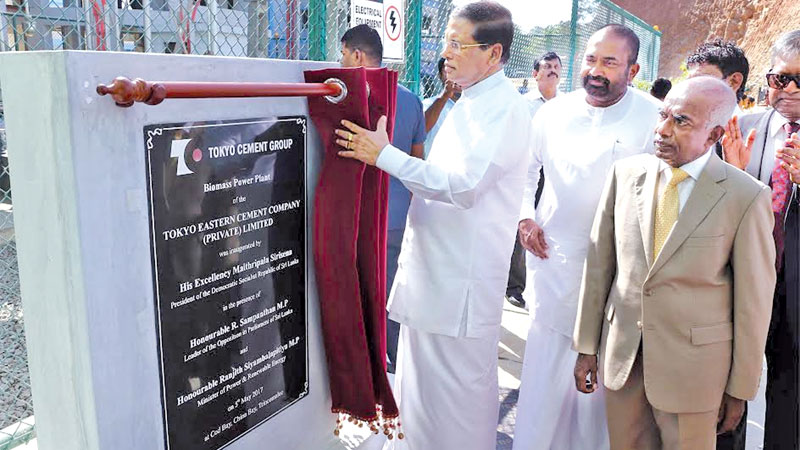
Tokyo Cement opens 2nd biomass power plant in Trinco

President Maithripala Sirisena inaugurates the Biomass Power Plant.
President Maithripala Sirisena last week ceremoniously inaugurated Tokyo Cement’s second Biomass Power Plant in Trincomalee as part of a series of events held in commemoration of the late founder Chairman A.Y.S. Gnanam.
The events included the foundation laying ceremony for a housing project for 25 families displaced during the war, distribution of deeds to residents of the Tokyo Cement Tsunami Housing Scheme in Nilaveli, foundation laying for a Technical Building and the commissioning of the Biomass Power Plant inside the Tokyo Cement Factory Premises at Cod Bay, China Bay.
“Mr. Gnanam was a pioneering entrepreneur who ventured into many of Sri Lanka’s firsts, which included the generation of Renewable Biomass Energy. President Sirisena’s visit to the Tokyo Cement Factory to inaugurate the company’s 2nd Biomass Power Plant with a capacity of 8 MW to power the company’s latest manufacturing facility, was a salute to his legacy that will continue to live on for generations to come,” the company said in a media release.
The over 2.5 billion-rupee power plant will add 70 Gwh per year to the national grid generated using industrial and agricultural waste sourced through community trade. In total, the plant will produce 160,000 MW Hours of clean renewable energy per year, equivalent to the annual electricity consumption of 100,000 Sri Lankan rural households.
S.R. Gnanam, Managing Director of Tokyo Cement said that the company has become the single largest contributor of renewable energy in the nation, generating 23 MW with the ability to supply 2.5 MW surplus capacity to the national grid.
http://www.sundaytimes.lk/170514/business-times/tokyo-cement-opens-2nd-biomass-power-plant-in-trinco-239700.html

The UN-REDD Programme on Reducing Emissions from Deforestation and forest Degradation (REDD+)
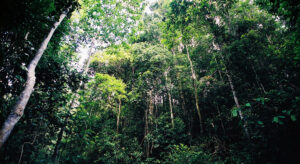 The UN-REDD Programme is the United Nations collaborative initiative on Reducing Emissions from Deforestation and forest Degradation (REDD+) in developing countries. The Programme was launched in 2008 and builds on the convening role and technical expertise of the Food and Agriculture Organsation of the United Nations (FAO), the United Nations Development Programme (UNDP) and the United Nations Environment Programme (UNEP). The UN-REDD Programme supports nationally-led REDD+ processes and promotes the informed and meaningful involvement of all stakeholders, including Indigenous Peoples and other forest-dependent communities, in national and international REDD+ implementation.
The UN-REDD Programme is the United Nations collaborative initiative on Reducing Emissions from Deforestation and forest Degradation (REDD+) in developing countries. The Programme was launched in 2008 and builds on the convening role and technical expertise of the Food and Agriculture Organsation of the United Nations (FAO), the United Nations Development Programme (UNDP) and the United Nations Environment Programme (UNEP). The UN-REDD Programme supports nationally-led REDD+ processes and promotes the informed and meaningful involvement of all stakeholders, including Indigenous Peoples and other forest-dependent communities, in national and international REDD+ implementation.
The first copy of the National REDD (Reducing Emissions from Deforestation and Forest Degradation) Investment Framework and Action Plan (NRIFAP) was presented to President Maithripala Sirisena this week. This is to begin implementation next year.
The UN REDD programme which expects to combat the threat of climate change is a collaborative initiative of the UN and will be completed as a five year (2018-2022), US$ 99 million strategy, financed through international sources.
A special invitee at the event was Vedda leader Uruwarige Wannialaththo who stressed the importance of protecting forests.
Forests play the unique role of converting harmful emissions into harmless carbon. REDD+ is recognized therefore as a global solution to greenhouse gas emissions. We at BSL are committed to support the Government in implementing this strategy.
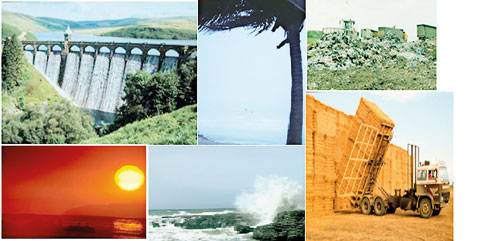
Benefits of electricity generation utilising waste management
Excerpts from a presentation made by B.R.O. Fernando, Past President of the Institution of Engineers Sri Lanka (IESL) and a former Vice Chairman of the Ceylon Electricity Board on Challenges and Opportunities in the Use of Renewable Energy at IESL and the British Council after attending a workshop on renewable energy organized by the World Renewable Energy Council in UK
Growing evidence has convinced most of the scientific community that some degree of climate change has taken place. This climate change is due to a small glitch in the sun’s output of energy or due to the activities of human kind or both. But the media and everyone else slip easily into the use of phrases like “greenhouse gases”and global warming.”
 The greenhouse effect of carbon dioxide and other gases present in the atmosphere has shown an increasing number of signs that the nature of the earth’s surface is beginning to change. The discussions held at Kyoto and Johannesburg have increased the awareness of renewable energy.It is worth mentioning that if we compare the emissions from electrical power plants we find that using coal or oil to generate produces 1110 gm of CO2 /KWH. Using gas reduces CO2 to 600 gm/KWH and biomass reduces CO2 dramatically to 16 gm/KWH. ((Ref: World Renewable Energy Congress 2002).
The greenhouse effect of carbon dioxide and other gases present in the atmosphere has shown an increasing number of signs that the nature of the earth’s surface is beginning to change. The discussions held at Kyoto and Johannesburg have increased the awareness of renewable energy.It is worth mentioning that if we compare the emissions from electrical power plants we find that using coal or oil to generate produces 1110 gm of CO2 /KWH. Using gas reduces CO2 to 600 gm/KWH and biomass reduces CO2 dramatically to 16 gm/KWH. ((Ref: World Renewable Energy Congress 2002).
The Meethotamulla garbage dump has raised and resulted in a hornets nest of insurmountable and unaccountable proportions, resulting in the loss of life to 32 innocent people and 30 missing persons followed by the devastation of their homes and livelihood. These poor people’s agony and disgust at living in an area inhaling an agonising smell with an unhygienic environment full of toxic gases, insects, worms and flies was not the general concern nor was it brought to the attention of some politicians of successive governments and health authorities for nearly two decades. This devastation of their livelihood was a blessing in disguise as it has now resulted in immediate measures to inspect and control the management of other garbage dumps around the country, and provided a planned scientific method for waste management techniques using landfills.
Biomass industries are an asset to any country where energy is generated from waste. A wide range of technological pathways are available, ranging from domestic open fires to bio-fermentation processes for the treatment of organic wastes of a community, to fully commercial complex thermo chemical reactors in the form of 100MW combined heat and power stations. Waste from municipal and industrial services represents an increasingly important fuel source that can be used to produce heat and power. Using these wastes as fuel can have important environmental benefits. Methane is a very potent greenhouse gas, 21 times more damaging than carbon dioxide emissions through displacement of fossil fuels produced by biodegradable waste and residue. When diverted to a landfill, gas is collected and used as a fuel (rather than allowed to escape in to the atmosphere, thus avoiding methane emissions). Contributions made at various forums look optimistically at renewable energy technologies of both those that are well established and those that are still a long way from making a commercial impact. Wind power, passive and electronic solar energy and certain new methods in the use of biomass have moved into the normal commercial world. Technologies such as waves, ocean, thermal and tidal energy and the hydrogen economy have not, as yet; but the prospects are still good and the potential benefits are enormous.
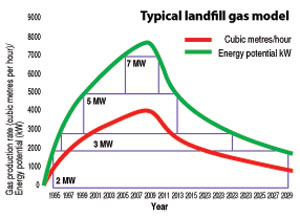 Biomass industries Energyfrom waste
Biomass industries Energyfrom waste
Biomass includes a wide range of chemically stored solar energy resources originating from plant material. Conversion into useful energy services and products can be undertaken using a wide range of technological pathways. Biomass products can vary in scale from simple combustion to domestic open fires to bio fermentation processes for the treatment of organic wastes of a community, to a fully commercial complex thermo chemical reactor in the form of 100 MW combined heat and power station.
Traditional biomass currently contributes from 12 to 13% of global primary energy demand, but is based mainly in the non-sustainable annual burning of 2×109 tonnes of firewood, 1.3×109 tonnes of crop residue and 1×109 tonnes of animal dung. Removal of this material from the land, robs the soil of recycled nutrients, exposes it to wind erosion, reduces the organic matter content and reduces the soil rooting depth. There are generic environmental issues relating to the biomass base. USA has fallen behind much of the world in the use of biomass and other renewable energy forms to produce electricity and steam. Instead USA embraced coal for energy production. Currently over 52% of US power is fueled by coal. CO2 emissions for US coal fired plants are estimated to be 2.3 million tonnes per year. The CO2 output of USA has increased by 20% since 1990 and millions of tons of sulphur in the form of SO2 and SO3 are emitted every year. Wastes from municipal and industrial services represent an increasingly important fuel source that can be used to provide heat and power. These types of waste are produced worldwide wherever there are centres of population. Using these wastes as fuels can have important environmental benefits. It can provide a safe and cost effective disposal option for wastes that could otherwise pose significant disposal problems. The use of waste as a fuel helps to reduce carbon dioxide emissions through the displacement of fossil fuels.
Any energy that is recovered from biodegradable waste can be regarded as renewable energy. It comes from carbon dioxide in the atmosphere. When the biomass material is used as a fuel, the CO2 is returned to the atmosphere in a “carbon neutral” cycle, and the biomass is used to displace fossil fuels. Instead of being left to decompose naturally, it will actually help to limit the emission of CO2 and methane to the air.There are many ways of combining waste disposal with energy recovery. The UK’s landfill gas industry is today one of the most developed in the world. For the last 45 years landfill gas has provided UK companies the ability to convert a potential hazard into a source of renewable energy. As the industrialised nations move towards reducing emissions to the atmosphere in an effort to stem global warming, landfill gas is fast becoming one of the chief areas of activity for developers, providing as has been proved in the UK, a low cost, reliable baseload with clear environmental benefits. During the past few years a capacity of more than 600MW of landfill gas has been commissioned.
Biomass resources converted to bio energy through technology routes
(Heat, power or transport fuels) Landfill gas
Energy can also be recovered from waste that had already been landfilled in the form of landfill gas (also referred to as biogas). In the process of anaerobic bacteria break down the organic fraction of the landfill in the absence of air, generates a mixture of gases comprising mainly methane, carbon dioxide, oxygen, nitrogen and many hundreds of trace compounds of gases as well as water vapor and waste products. The biogas can be collected by drilling wells into the waste and extracting it as it is formed. After cleaning, it can be used in an engine or turbine for power generation, or used to provide heat for industrial purposes such as brickworks situated near the landfill site. Landfill sites can develop commercial quantities of “landfill gas” for up to 30 years after the waste has been deposited. The graph given above is a graphical representation of landfill gas and energy availability against time. The gas is normally collected from a series of vertical boreholes that have been purpose drilled in to the site.
As mentioned earlier, methane has a greenhouse gas potential of approximately 21 times that of carbon dioxide and although methane is eventually oxidized in to the atmosphere, the uncontrolled release of landfill gas contributes significantly in emissions of greenhouse gas and thus global warming The International Panel on Climate Change (IPCC) estimated that landfill gas contributed to between 20 million tonnes and 70 million tonnes of methane in the atmosphere in 1990. Estimated emissions of methane from solid waste disposal within the 15 European Union countries rose from 7,233,000 tonnes in 1994 representing the largest single source of methane and around 33% of the total, in the EU. Removal of methane emissions and conversion to carbon dioxide, provides a valuable contribution to the reduction of greenhouse gas emissions. A typical 1MW landfill gas project will reduce gas emissions by around 30,000 tonnes an year.
Anaerobic digestion
The biological processes that take place in a landfill site can be harnessed in a specially designed vessel known as an anaerobic digester, to accelerate the decomposition of wastes. Anaerobic digestion is typically used on wet waste such as sewerage, sludge or animal slurries. But the biodegradable fraction of municipal wastes can be added to wetter wastes to increase the biogas output.
The rapidly expanding functions of the renewable sector worldwide is comparable to that of the oil and gas sectors in the early 1970s.The positive roll continues today. The experience gained after 45 years, in oil and gas will undoubtedly continue to the development of renewables. As part of the climate change strategy most countries the world over have established their targets for the renewables obligation of 10% of the total electricity supply, by the year 2010 recognising the renewable’s contribution to the reduction of CO2 emissions.(However Sri Lanka failed to comply with this.) This was achieved by the requirement placed on electricity supply companies to source an increasing proportion of their supply from “green energy.” Companies that have failed to do this, have the option of buying out their “obligation” at an initial US$42.5/MWH, such monies when paid are distributed among the companies that did meet the obligation.
In such a scenario, wind power will be an obvious winner offering as it does rapid deployment of electricity generating plant at the lowest prices, anywhere in the European Union. Wind power is a technology that has wide support especially in the UK, with off shore and on shore wind which are most strongly supported. Energy from waste makes up a useful part of an integrated waste management system. Furthermore, renewable and greenhouse reduction targets require the exploitation and support of all available clear technologies. Landfill gas clearly offers large potential for the development of projects in countries where carbon certification will provide a degree of financial support for the investment required. The Sri Lankan government should take immediate steps on this vital issue as tonnes of waste are deposited daily in various parts of the country, which is indeed an environmental and health hazard. The present Government should immediately initiate industries in various parts of the country where garbage dumps are in existence to generate electricity, recycle the waste and produce composts as fertilisers and also to earn valuable foreign exchange from carbon certification by generating electricity.
I wish to conclude by drawing attention to a document produced in April 2002 by the National Energy Laboratory in Colorado and operated by the US Department of Energy by Midway Research Institute, wherein the advances made from 1977 to 2002 after 45 years of research excellence are given with the predicted performances in 2020 for bio energy, solar and wind energies
Source – 14/05/2017, The Sunday Times, See more at – http://www.sundaytimes.lk/170514/sunday-times-2/benefits-of-electricity-generation-utilising-waste-management-240025.html

Limits on ground water use viewed with suspicion
Local authorities have been asked to strictly enforce new regulations to prevent over extraction of ground water amid fears that water levels are declining.
But farmers suspect this is an attempt to tax water resources through regulation in the long-term.
The latest regulation which has been gazetted will be implemented island-wide to protect ground water, chairman of the Water Resources Board (WRB), A.C.M Zulficar said.
Only 30,000 litres of water per month will be allowed to be tapped from the ground.
Zulficar said ground water levels have dropped 4.5 metres below ground in the coastal areas although the normal level should be 1.5 metres below ground.
“Due to overuse of ground water in Jaffna, the water had been completely drained and sea water had seeped inland, while Puttalam is also an affected area,’’ Mr Zulficar said.
All government, local government or non-government organisations and institutions including individual users have to submit detailed reports of their water requirements as projects to obtain approval, he said.
Written permission of the WRB should be obtained for building agro wells of the depth of four metres or more, or for wells or tube wells for commercial agriculture and industry.
The industries include bottled water, beverages, hotels, livestock farms and coir and rubber industries.
Zulficar said a grace period is effective until the end of this month.
Industrial users of ground water should fix flow meters to monitor the amount of water pumped from a well, keep records of daily use, and maintain capacity.
Records should be provided to the WRB every three months, while any institute or an individual engaged in bottling water, and bottling beverages using springs, should have samples analysed by a reputable chemical laboratory every six months.
WRB only allows to extract 30,000 litres of ground water per month, for industrial, commercial, and agricultural use, Zulficar said.
“So far, we have received around 150 applications and 70 of them for digging agricultural wells, while 90 tube well miners have been registered. There are also 250 tube wells,” he said.
Additional District Secretary of Puttalam, W.M.C.K Wanninayake, said that the dry weather had forced the shift to the use of ground water.
He said that the WRB has informed them of the situation.
The Pradaeshiya Sabha has been informed and has been asked to deploy water tankers to supply water.
“We instructed our officers to implement the regulations when recommending tube wells,’’ he said.
In Nuwara Eliya, Divisional Secretary Sujeewa Bodimanna, said awareness programmes have begun.
Meanwhile, the All-Island Farmers Federation, national organiser, Namal Karunaratne, welcomed the moves to protect ground water. But farmers suspect that registration of wells is being required so that taxes can be imposed.
Mr Karunaratne said that the government should also stop illegal land filling, sand mining and also build more tanks to help preserve ground water.
He complained that while large scale beverage industries are allowed to use water others are being asked to register including tube well creators. So while actions are being taken to protect ground water, streams will be exhausted.
Environmentalist of the Biodiversity Conservation and Research Circle, Supun Lahiru Prakash, said that the ground water levels have to be preserved through the Water Resources Management act.
He said that the ground water table is a valuable resource.
Mr Prakash said that the Government should also consider the environmental impact and the pollution of the water. He said that the Government first should stop dumping garbage in marshy areas that feed the ground water.
The Government also should limit the amount of water used by industrial and commercial users who use ground water for beverages and bottled water.
He said that rather than imposing a limit of 30,000 litres a month, limits should be devised based on water volumes under ground.
Source – 14/05/2017, The Sundat Times, Read more at – http://www.sundaytimes.lk/170514/plus/seeing-the-blue-mountains-for-the-first-time-239963.html

Seeing the Blue Mountains for the first time
It was to be Australia’s first ever national gathering of those who had walked – or had an interest in – the ancient Spanish pilgrim trail called The Camino of Santiago.
I was enthusiastic to attend this conference partly because I had been invited to give a presentation based on the book I had written about this 800 kilometre trail which I had walked with my son a few years ago. I was even more enthusiastic to go because I had never been to this beautiful part of Australia previously!
Located west of the big city of Sydney, the picturesque Blue Mountains may be described as a “hill country” for vacationing Sydneysiders. It is close enough to reach from Sydney (one hour by car and 90 minutes by train) yet far enough away to constitute a mountainous rural landscape ideal for hiking, bushwalking, rock-climbing- and just relaxing in a cool and salubrious climate.
The Blue Mountains are so called because of the bluish tinge taken on by the mountain range when viewed from afar – thought to be due to gases termed Volatile Organic Compounds (VOC) that are emitted by the hordes of eucalyptus trees covering the mountains. The gas particles in the air scatter the shorter (violet to blue) wavelengths of light, resulting in a blueish haze over the mountains when they are seen from a distance.
The Blue Mountain region received UNESCO World Heritage listing in 2000, being recognised for its outstanding diversity of habitats and plant communities. The large area of natural wilderness includes seven national parks blessed with towering cliffs, grand canyons, amazing rock formations (including the famous one called ‘The Three Sisters’) and spectacular waterfalls. The temperate rainforests here host various different species of eucalyptus trees and several species of endemic animals including Australia’s famous koala bears.
While in Blackheath we drove to Govett’s View Lookout and from there did a fifteen minute climb to visit the magnificent Govett’s Leap waterfallwhich drops an amazing 180 metres from the top of the cliff. If you would like a virtual three dimensional view of Govett’s View Lookout, go to http://www.nationalparks.nsw.gov.au/things-to-do/lookouts/govetts-leap-lookout and click on Google Street View Trekker.
Though it is a small country town – a big village really – Blackheath is a popular place for visitors, boasting some great walking tracks and beautiful scenery. We were able, during our time there to hike to a couple of the famous lookouts, including Baltzer Lookout from which one has a good view of the famous Hanging Rock. We also visited the Dhamma Bhumi Vipassana Meditation Centre in Blackheath which offers residential courses in Vipassana Meditation.
The highest town in the Blue Mountains is Katoomba which has a host of activities for the visitor – the Blue Mountains Cultural Centre which is a well-known regional art gallery, the black granite Peace Memorial sculpture in the Civic Place gardens, the Waradah Aboriginal Centre where we were able to watch performances of traditional Aboriginal dances and learn about the culture of Australia’s indigenous people from members of the local tribes themselves.
A 15 minute drive south of Katoomba took us to Scenic World which offered rides on what they claim to be is the steepest passenger railway in the world, going down some 300 metres through a cliff-side tunnel to emerge on the floor of the Jamieson Valley into luxuriant temperate rainforest. From here we were able to explore the rainforest along the scenic walkway, a mile long boardwalk built just above the floor of this ancient valley and protected by the canopy of trees towering above us.
I have always enjoyed travel, and I have come to believe that a conference is a good excuse to make a visit to experience places that I have not seen before.
After all, as the Japanese poet Matsue Basho observed, “I will see with my own eyes remote places of which I have only heard”!
Source – 14/05/2017, The Sunday tims, See more at – http://www.sundaytimes.lk/170514/plus/seeing-the-blue-mountains-for-the-first-time-239963.html

Sri Lanka Navy arrests 6 local fishermen illegally harvesting sea cucumber
May 08, Colombo: The Sri Lanka Navy Monday said it has arrested six local fishermen for allegedly engaged in illegal harvesting of sea cucumbers.
Naval personnel attached to the Northern Naval Area arrested the six persons while harvesting sea cucumbers using illegal fishing methods in the seas off Point Pedro yesterday (7).
Along with the suspects, approximately 280 sea cucumbers, 6 diving masks, 5 pairs of diving fins, 5 regulators, 4 diving torches, 20 oxygen bottles and 2 FGDs were also taken into naval custody.
The arrested persons and the items were handed over to the Fisheries Inspector, Point Pedro for onward legal action.
Sea cucumber fishing is not banned in Sri Lanka but allowed only with a permit to prevent over exploitation of marine species and adversely affecting the marine eco system.
Source – http://www.colombopage.com/archive_17A/May08_1494226096CH.php
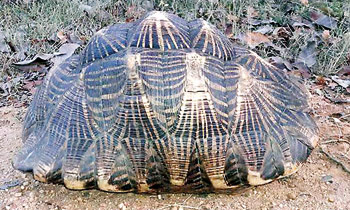
World’s biggest star tortoise found in Lunugamvehera?
A star tortoise weighing 13 kilogrammes – believed to be the world’s biggest and heaviest – has been found by wildlife officers from the Lunugamvehera National Park.
This tortoise is believed to be the biggest tortoise found on far in the world. This tortoise which belongs to the Chelonian species has been recognized by the people as striped tortoise, forest tortoise,’ Mevara’ tortoise,’ Huniyan’ tortoise (Black magic tortoise), spring bean tortoise and Batakeya tortoise.
This species has got used and adapted to the dry land properly. The world’s biggest tortoise known so far is said to be weighing between 8 to 9 kgs. Therefore, wildlife officers are of the opinion that this is now the biggest tortoise that has been found in the world.
(Nayanajeewa Bandara)
Source – 09/05/2017, Dailymirror- See more at: http://www.dailymirror.lk/article/World-s-biggest-star-tortoise-found-in-Lunugamvehera–128586.html#sthash.0rowQtXr.dpuf
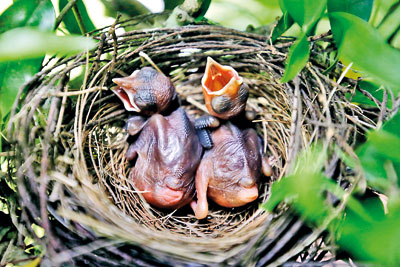
Galle’s wonderland that is ‘Serengeti’ By Kumudini Hettiarachchi
Sitting atop Galgamu-kanda, accessed by a winding, steep pathway is ‘Serengeti’ in Walahanduwa, with a view of the sea off Galle in the hazy and sunny distance.
‘Serengeti’ surrounded by lush greenery, large trees giving a wide canopy, smaller trees, plants, bushes and undergrowth is the home of Sarath and Premila Seneviratne.
Nay, it is not just the home of this retired couple, but also of bees, butterflies, birds and various small mammals.
It is a veritable birds’ paradise as we sit on the verandah sipping a delicious home-made drink from fruit picked from the garden with kasa-kasa temptingly at the top before a sumptuous luncheon, with a spread of vegetables also from the garden.
Suddenly, we hear the hungry chirping of baby birds and Sarath, with finger to lips, gently moves the branches of a kiri nuga bush near my chair to reveal a nest of the Red-vented bulbul with two nestlings in it.
A retired banker who has worked in remote areas, Sarath developed a passion for nature when his mother gifted him his very first book on birds when he was about seven years old and studying at St. Aloysius College, Galle. Their family home was at Hikkaduwa and he would keep cotton for birds such as bulbuls to take and make their nests. He would use the wall of his home as a marking-board to detail when eggs nestled within and when they would bring forth the babies. Later, as the family grew, he would keep a small bench to gain height to see the parent-birds feeding their young.
Being from a family of nine, Sarath who was the fifth boy says that there was no money for lavish spending and it was the pocket money for tiffin that he saved, when living with his Punchi Amma as it was closer to school. He would also ramble up the ramparts in search of birds, while scanning the newspapers to check out any books that were being published. Then he would make a beeline to the Universal Book Store in Galle to order them.
These precious acquisitions and much more including valuable collector’s items in the form of First Editions (all books of W.W.A. Phillips, G.M. Henry etc) tightly-line a large cupboard in his home. Details about the authors, including yellowed and frayed news-clippings and any letters Sarath had written to them along with the replies have been tenderly pasted on the books. This is while numerous photographs of birds are up on the walls.
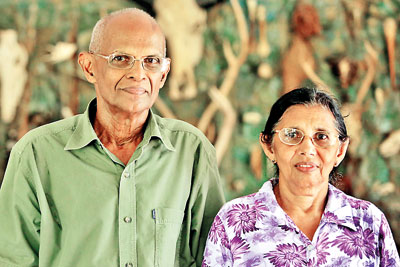
The ‘wild’ trait had seen rapid progression, with Sarath joining the Wildlife and Nature Protection Society (WNPS) way back in 1961 as a schoolboy, being one of its oldest members recognized in 2012 as having an unbroken membership of 50 long years. Soon a request from well-known conservationist Thilo Hoffman — who has been credited with being the saviour of Sinharaja against its rape – had followed to join the Bird Club which he did most willingly in 1975.
Nature lovers: Sarath and Premila
Sarath had also palled up with well-known author T.S.U de Zilwa and in an era when digital photography was still unheard of, to enable the ‘capture’ of bird-images in their different forms of nesting, feeding et al, would provide photography hides for him. (Such ‘hides’ are purpose-made constructions for a photographer to get closer to a bird than would be normally possible if he was in full view.)
“We would take-off on such missions over the weekend, build high scaffoldings and use the ‘hides’,” laughs Sarath going down memory lane to Kumana, Bundala and other locations where birds were aplenty.
These numerous images so captured adorn T.S.U’s lovely books.
Before we go on a tour of the nature wonderland that is ‘Serengeti’, Premila, goes back to those early days. They had fallen in love with the land but there was no water or electricity. Their very first action in the early ’70s was to construct a small tank for rain-water harvesting and then sit and think how they would lug the building materials needed for their home up the hill.
It was Premila who moved into their partially-built home with their eldest son, 10-month-old Hemantha. Two more sons enriched their family, Sampath (who incidentally has taken up molecular ecology and evolution as a Research Scientist & Senior Lecturer in Zoology at the University of Colombo) born in 1977 and Leelanga in 1980.
Gradually, Sarath and Premila turned this patch of land into an exotic beauty-spot — like its namesake National Park in Tanzania — where if there is a slight delay, the birds in the wild clamour for their food and recognize their small car, a Viva Elite, as it climbs the last stretch home, giving them a guard-of-honour.
By 1984, Sarath was also very much a part of the team taking the bird census which he continued even in challenging times such as the youth insurrection of 1988-89. Husband and wife would take the essentials including the telescope tied to the motorcycle and a bare minimum of a bottle of water, while their three sons were in school, and follow the trail of birds, once even passing the body of someone who had been killed in the unrest.
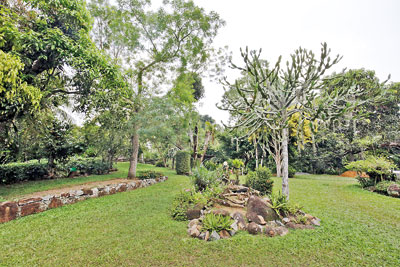
As a gentle breeze moves the foliage this way and that and common mynahs, Rose-ringed parakeets, sunbirds, White-backed munias, Black-hooded orioles and even the rare Yellow-naped green woodpecker fly around, butterflies flit from bush-to-bush, squirrels scurry hither and thither and a thalagoya (iguana) seems to show the way, we walkabout untroubled by the afternoon heat.
From the verandah, our first stop is the ‘amphibian cave’, the hollow of a tree; then passing creepers, bushes, plants and trees such as veni-val, kiri-nuga, magul karanda, an-kenda, uguressa, delum, atteria, all kinds of lime trees, we come upon the ‘bat hollow’ set up for insect-eating bats, and jump over a stile to take a look at the ‘vegetable patch’ of wetakolu (ribbed gourd), maalu-miris (capsicum), wattakka (pumpkin), karawila (bitter-gourd), iringu (corn), rabu (radish), nivithi (spinach) lovingly tended by Premila and then tea-lands and more. The rainwater harvesting tank is still intact but bigger.
Both Sarath and Premila are justifiably proud of the exotic orchids including the Vesak orchid (Dendrobium maccarthiae) and Vanda tessellata they have nurtured.
It is after a long and relaxing afternoon watching myriads of birds at ‘Serengeti’ that we bid goodbye to Sarath and Premila, in total agreement with Sarath that watching birds is a “bavanawa” (meditation) in itself.
By Kumudini Hettiarachchi
Source – 07/05/2017,The Sunday Times, see more at – http://www.sundaytimes.lk/170507/plus/galles-wonderland-that-is-serengeti-239064.html

